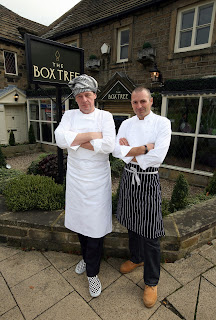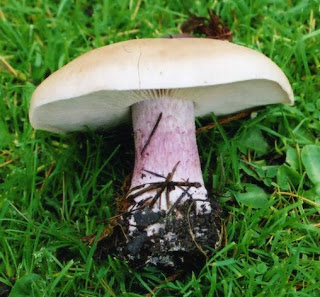A few weeks ago I interviewed a lovely man from New York called Richard Eshelman for the Guardian Weekend magazine. The Guardian's online article can be seen here.
Richard talked openly to me about his experience of eating some of the most deadly wild mushrooms on the planet: a handful of destroying angels.
Luckily, Richard survived, but came very close to death. He is still a keen wild mushroom forager. He admits that the mistake he made was to not identify the wild mushrooms he had picked properly before he ate them. Here is his experience:
 |
| Richard Eshelman: I ate deadly wild mushrooms |
"Four years ago, a few days before my 56th birthday, I went to one of my favourite spots – a park about a quarter of a mile from my home in Ithaca, New York.
"That summer had been hot and humid, and there were mushrooms everywhere. I saw some on the ground I thought were edible ink caps – white, with their caps down. I also spotted a bigger mushroom nearby with its cap open – it looked poisonous to me. I should have remembered that mushrooms grow in colonies: it was likely that the lone bigger mushroom and the smaller versions were the same. But I didn't think. It was a glorious day and I felt invincible. I picked three or four of the small ones and took them home.
"As a young man, I used to look for morels and meadow mushrooms. At college, I'd taken a course in mushroom hunting. I didn't consider myself an expert, but I did know that there was a very toxic mushroom called the destroying angel, one of the most deadly mushrooms in the world.
"At home, I spent some time looking for my mushroom book to identify what I'd picked, but couldn't find it. I was in a rush because I was going out, so I thought, "It's OK, I know what I'm doing. These are definitely ink caps." I fried them with butter and ate them as a side dish. Ink caps usually give out a residue when you cook them. These didn't, which should have been my first clue that they weren't what I thought they were. They didn't taste great – in fact, there was something quite bland about them. "I won't bother eating these again," I thought.
"That night, I told friends I'd just eaten wild mushrooms. One asked if they'd had white caps and gills, and I said, yes. She told me her mother said never eat mushrooms that are white all over. I shrugged it off and said I knew what I was doing. But she planted the first seed of doubt.
"The next morning, I woke up about 4am, ran to the bathroom and started throwing up. Then the diarrhoea began. I thought, perhaps my friend was right; maybe I've eaten poisonous mushrooms.
"I went again to look for my mushroom book, which I now found. I looked up the destroying angel – and there were my exact symptoms: eight hours after eating, it will cause vomiting and diarrhoea. And then it destroys your liver – there's no antidote and 60-80% of people don't survive. I realised I'd made the biggest mistake of my life.
"The scary thing about the destroying angel is that it tricks you into thinking you are making a recovery. After the vomiting and diarrhoea, you start to feel better. Knowing this, I acted quickly and called the hospital. They recommended going back to where I picked the mushrooms to see if I could find another so they could identify it – which is what I did. Then I drove myself to the emergency room. As I left my house, I thought, "Look around, you may never be back here."
"At that point, I hadn't told anyone else that I suspected I'd poisoned myself. I called work, because I had a shift that night. Eventually, I called my girlfriend. I felt embarrassed that all my friends and family would know I'd made such a terrible mistake.
"The doctors ran some tests and confirmed I'd eaten the destroying angel. I was the third person that year to be admitted after eating one. The two before me hadn't survived. I was sent to another hospital a few hours away; it was the best place to be if my liver failed and I needed a transplant.
"I was still vomiting and the diarrhoea was constant. I had tubes down my throat, and the doctors took blood samples every hour to monitor my liver. They asked me questions to check I was lucid. The critical night was on Friday, three days after I'd eaten the mushrooms, when I went into intensive care. I was given high doses of penicillin and the next morning my liver began to recover. I didn't need a transplant, but my kidneys were badly damaged. I was kept in for another week. All I know is that I survived – one doctor said it was a miracle.
"I haven't had the courage to pick wild mushrooms since – I don't trust myself – but my experience shouldn't deter others. The mistake I made was assuming I knew what I was eating. I wasn't paying attention and I'm lucky to be alive."







